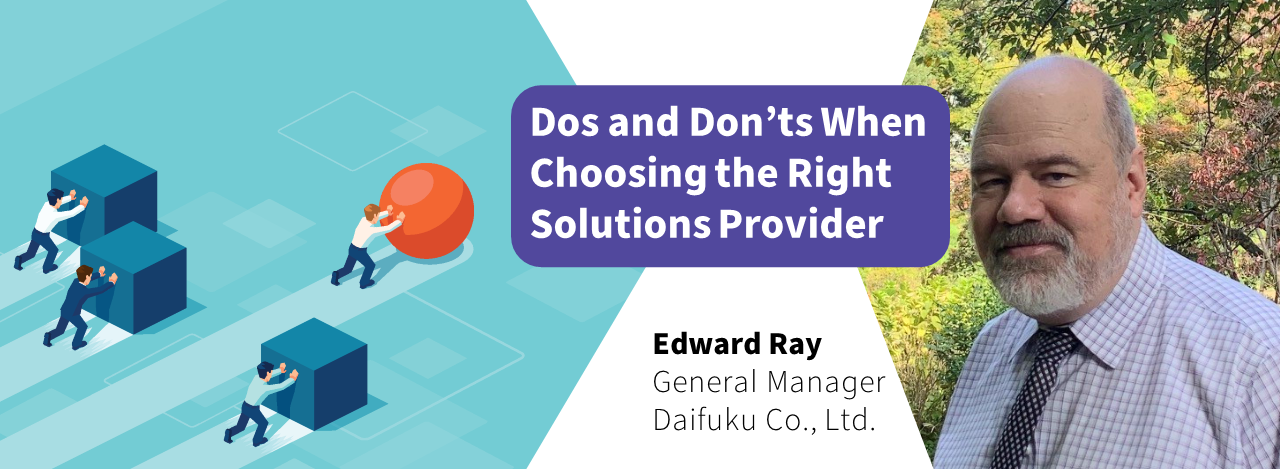올바른 솔루션 제공업체를 선택할 때 해야 할 일과 하지 말아야 할 일

물류 업계에서 오랜 세월 일하면서, 저는 회사들이 Intralogistics 시스템을 위한 솔루션 공급업체를 어떻게 선택하는지 지켜보는 특권을 누렸습니다. 이러한 시스템은 종종 수백만 달러 규모의 제안이 될 수 있으며, 여러 부서가 의사 결정 과정에 참여해야 합니다. 일부 회사는 전문 지식을 위해 컨설턴트를 데려오기도 합니다.
많은 자동화 솔루션이 CAPEX 집약적이기 때문에 회사의 자금을 보호하기 위해 모든 것을 심사하는 분위기가 존재합니다. 당연히 계획에 참여하는 사람들은 최선을 다할 것입니다. 그러나 그 계획은 때때로 비생산적인 수준으로 진행될 수 있습니다.
계획할 때 제공할 솔루션의 관점에서 상황을 살펴보는 것이 중요합니다. 그 단계는 당신이 참여할 수 있는 불필요한 단계를 밝히고 진정한 결과를 가져올 단계에 노력을 집중할 수 있도록 도와줍니다.
위의 점을 염두에 두고 다음과 같은 해야 할 일과 하지 말아야 할 일을 클라이언트가 훌륭한 솔루션을 얻기 위해 고려하는 것이 좋습니다.
해야 할 일과 하지 말아야 할 일
도스
- 어떤 방식으로든 내부물류와 관련될 수 있는 모든 비즈니스 규칙을 문서화하고 이를 참가자와 공유합니다.
- 기본 계획에 필요한 원시 데이터(피크 및 평균 주문 라인 날짜, 재고 스냅샷)를 수집합니다. 또한 계획을 위해 데이터에 적용해야 하는 성장 요인을 정의하십시오.
- 자동화된 자재 처리 시스템과의 인터페이스가 필요한 기존 비즈니스 시스템(ERP, OMS 등)의 차트를 만듭니다.
- 초기 단계에서 현재 운영 관리를 프로젝트에 참여시키십시오. 처음부터 승인을 받으면 새 시스템으로 운영을 전환하는 동안 성공에 대한 책임을 지게 됩니다.
금지 사항
- 원시 데이터를 직접 소화하는 데 많은 시간을 소비하지 마십시오. 공급업체는 제안서 생성 프로세스의 일부로 이 작업을 수행할 수 있습니다.
- 솔루션을 직접 구축하지 말고 RFP에 넣어 공급업체 간에 비슷한 비교를 받으십시오. 공급업체가 고유한 기능을 제안하도록 하십시오.
- 통합자 역할을 맡지 마십시오(이미 경험이 많지 않은 경우).
- 계획/의사결정 과정에 필요 이상으로 많은 시간을 할애하지 마십시오.
벤더를 선택하는 이상적인 방법
- 설치가 완료될 국가에서 활동 중인 평판이 좋은 공급업체를 결정합니다.
- RFI와 높은 수준의 제안을 조합하여 편안하게 협력할 수 있는 공급업체를 신속하게 결정하십시오. 하나의 공급업체만 적합한 것처럼 보인다면 훌륭합니다! 단독 소스로 이동합니다.
- 공급업체가 결정되면 예산을 알려주고 해당 예산의 제약 내에서 가능한 최상의 시스템을 제공하도록 요청하십시오.
시간 극대화
가능한 한 빨리 작업할 수 있는 공급업체를 찾는 것이 가장 좋습니다. 주된 이유는 설계를 검토하고 제안된 솔루션으로 변경 관리 전략이 올바르게 계획되었는지 확인하는 데 양질의 시간을 보내고 싶을 것이기 때문입니다. 단일 벤더와의 집중 세션은 위험을 줄입니다.
RFP를 발행한 다음 여러 공급업체 제안을 기반으로 "조율된 RFP"를 다시 발행하는 함정에 빠지지 마십시오. 가장 낮은 가격을 받고 있는지 확인하기 위해 유사한 비교를 시도할 수 있지만 라인별로 다른 공급업체의 자재 취급 솔루션을 비교하는 것은 요점을 놓치고 있습니다. 그들이 가장 잘하는 솔루션. 또한 설치 장소와 필요한 설치 시간 프레임은 각 벤더의 가격에 다르게 영향을 미칠 수 있습니다.

시간은 돈이다. 유사 비교를 수행하면 결국 전체 비용이 가장 낮아질 수 있습니다. 그러나 당신이 객관적이라면 비슷한 비교를 시도하고 얻기 위해 그 모든 시간을 투자하는 데 귀중한 시간이 든다는 것도 분명해질 것입니다. 벤더가 이미 선택되어 있었다면 시스템 설계 및 기타 중요한 활동에 그 시간을 할애할 수 있었습니다.
비용을 예산 범위 내에서 유지하는 핵심은 예산이 얼마인지 공급업체에 명확히 알리는 것입니다. 공급업체는 가능한 최고의 시스템을 제공하기를 원할 것입니다. 단일 공급업체를 선택하는 경우, 그들은 조금 더 많은 마진을 유지할 수 있지만 대부분의 사람들은 빠른 일회성 이익보다 만족한 고객과의 장기적인 관계에 더 관심이 있을 것이며 가격 폭등을 방지할 것입니다.
공급업체 선택 시간을 절약하면 새 시스템의 이점을 더 일찍 얻을 수 있습니다. 또한 "예산 내에서 최선을 다한" 공급업체와의 관계는 상호 신뢰 관계가 될 것입니다.
토털 솔루션 경험
Daifuku가 고객과 어떻게 협력하는지 알고 싶으십니까? Total Solution Experience 페이지를 확인하십시오.
에드워드 레이

Daifuku의 Intralogistics 부문 총괄 매니저
Edward Ray는 자동화된 물류 산업에서 30년 이상의 경험을 가지고 있으며, 그 중 대부분은 국제 사업 개발에 투자했습니다. 그는 도쿄에 거주하며 현재 Daifuku Co., Ltd.의 Intralogistics Division에서 영업 총괄 관리자를 맡고 있습니다. Edward는 또한 Daifuku Group 회사인 Daifuku Intralogistics India와 Daifuku Oceania의 이사회 멤버이기도 합니다.
